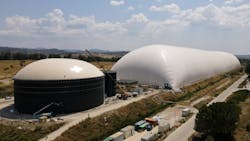Google Partners with Energy Dome to Scale CO2 Battery Storage for Renewable Power
Search engine and artificial intelligence technology giant Google, which already is trying to secure its future power load needs with renewables and nuclear energy, is making a long-term partnership and investment deal with Energy Dome to scale up carbon dioxide (CO2) battery storage for its operations internationally.
Google’s first commercial foray into long-duration energy storage (LDES) as an alternative to the currently predominant lithium-ion batteries is an attempt to widen the options for carbon-free energy capacity beyond intermittent solar and wind power purchase agreements. Milan-based Energy Dome will deploy its CO2 battery technology to support Google operations at various locations globally.
The digital infrastructure firm also is making a “strategic” but financially undisclosed amount of investment in Energy Dome, the companies say.
“Google is committed to powering our operations with clean energy, and Energy Dome’s technologically proven and scalable long-duration energy storage solution can help us unlock rapid progress,” said Maud Texier, director of EMEA Energy at Google, in a statement. “But this isn’t just about Google. By helping to scale this first-of-a-kind LDES technology, we hope to help communities everywhere gain greater access to reliable, affordable electricity and support grid resilience as we integrate more renewable energy sources.”
More Innovations on Path to Net Zero in EnergyTech
The Google-Energy Dome agreement aims at supporting development of CO2 battery projects in Europe, North America and the Asia-Pacific region. The project pipeline has identified sites, although those are currently in contracting stages and not revealed publicly yet.
Energy Dome recently established its Asia-Pacific headquarters in Melbourne, Australia. The company previously has announced an energy storage offtake deal with global energy firm ENGIE in Italy, NTPC in India, and its first U.S. contract with Alliant Energy.
“The programmatic and strategic deployment of our technology at scale to help Google reach carbon-free energy represents the core of our industry-first agreement. We’re proving that a 24/7 cost-effective and carbon-free energy supply is achievable with the right technology and partnership model,” said Claudio Spadacini, founder and CEO of Energy Dome. “We are also pleased to welcome Google as an investor in Energy Dome, underlining our joint commitment to a shared vision.”
Energy Dome’s CO2 battery is based around a closed thermos-mechanical process that involves CO2 between its gaseous and liquid phases. The carbon dioxide warms up, evaporates and expands, which turns a turbine to generate electricity, according to the company. What turbines provide is spinning reserve or grid inertia needed to maintain frequency on transmission systems.
The technology may reduce costs and energy waste, according to Energy Dome, by storing the CO2 at ambient temperature in its liquid phase. The technology works on a closed-loop cycle, utilizing CO2 from the dome and converting it between the liquid and gas phases.
Energy Dome’s CO2 batteries can dispatch power for 8 to 24 hours, the company says, which is much longer duration than possible with lithium-ion chemistries. Energy Dome’s CO2 battery also reportedly has a longer shelf life than lithium-ion counterparts.
Carbon dioxide is liquified by combining high pressure with low temperatures, according to various reports. The liquid form of CO2 is often used in food preservation, fire extinguishers and commercial food processing.
The rise of AI and data center demand, reportedly beyond that the current utility grid can handle, is empowering big tech firms such as Google, Meta and Microsoft to seek alternative, independent PPAs with power generators and project developers.
Many of those are long-term virtual PPAs to invest in utility-scale wind and solar power, but lately many of the tech firms are exploring next-gen nuclear technology developments.
The Global Battery Storage Race is On
EnergyTech's E-Book on Competition for Energy Storage Supremacy
About the Author
Rod Walton, EnergyTech Managing Editor
Managing Editor
For EnergyTech editorial inquiries, please contact Managing Editor Rod Walton at [email protected].
Rod Walton has spent 17 years covering the energy industry as a newspaper and trade journalist. He formerly was energy writer and business editor at the Tulsa World. Later, he spent six years covering the electricity power sector for Pennwell and Clarion Events. He joined Endeavor and EnergyTech in November 2021.
Walton earned his Bachelors degree in journalism from the University of Oklahoma. His career stops include the Moore American, Bartlesville Examiner-Enterprise, Wagoner Tribune and Tulsa World.
EnergyTech is focused on the mission critical and large-scale energy users and their sustainability and resiliency goals. These include the commercial and industrial sectors, as well as the military, universities, data centers and microgrids. The C&I sectors together account for close to 30 percent of greenhouse gas emissions in the U.S.
He was named Managing Editor for Microgrid Knowledge and EnergyTech starting July 1, 2023
Many large-scale energy users such as Fortune 500 companies, and mission-critical users such as military bases, universities, healthcare facilities, public safety and data centers, shifting their energy priorities to reach net-zero carbon goals within the coming decades. These include plans for renewable energy power purchase agreements, but also on-site resiliency projects such as microgrids, combined heat and power, rooftop solar, energy storage, digitalization and building efficiency upgrades.

